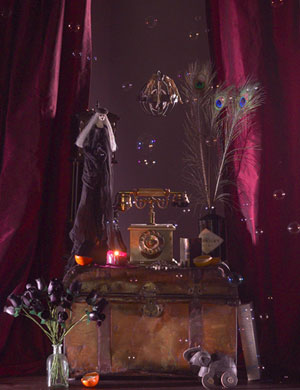

Scheherazade's Children
by Jenni Fagan
Wendy B. Faris
 The essay 'Scheherazade's Children' begins part II; Theory, of the critical anthology 'Magical Realism, Theory, History, Community by Zamora and Faris.' Faris puts forward a parallel between post-modern authors of Magic Realism and the famous tale of 'One Thousand and One Nights.' In the story King Shariyar responds to his wife's infidelity by sleeping with a new virgin each night and then having them killed the next morning. Scheherazade's Father sources the virgins for the King and when they run out Scheherazade puts herself forward hoping to save her father's life. Each night she tells the King a story but each one connects into another so he must wait until the next night to find out what happens, until after a thousand and one nights and after bearing the King three children, she faces up to him and he concedes that he will not kill her. Faris pulls out three main strands of Scheherazade's tales focusing on the 'auto generative nature of fiction 1.' Also how Scheherazade is using language to weave magic, to save her own life and her father's, and of course her ability to create characters each night that may echo or double or revive those that have gone before. 'Magical realism combines realism and the fantastic in such a way that magical elements grow organically out of the reality portrayed. I invoke Scheherazade's children as its standard bearers because they might be imagined as "replenished" post-modern narrators, born of the often death-charged atmosphere of high modernist fiction, but able somehow to pass beyond it 2.' Faris looks at examples such as 'The Angels' by Milan Kundera where protestors rise up through the air over a city square, incited by poetry. She highlights this continuing a long tradition of magic created by language that has been inherent in myth and storytelling since the beginning of time. While the essay refers to the Latin American roots of Magic Realism it widens out the platform to encompass Magic Realism authors worldwide focusing mostly on current contemporary works. She notes that the title of the essay is a nod to Midnight's Children by Salman Rushdie, which she says; 'Exemplifies the mode of magical realism best for my purposes here—among other reasons because it is quite real, quite magical, and not from Latin America, where the genre is usually imagined to reside 3.' A main element that makes the essay accessible and concise is the layout of five leading characteristics of Magic Realism as points from which to explore the genre. I will attempt to distil some of the essence of each section.
The essay 'Scheherazade's Children' begins part II; Theory, of the critical anthology 'Magical Realism, Theory, History, Community by Zamora and Faris.' Faris puts forward a parallel between post-modern authors of Magic Realism and the famous tale of 'One Thousand and One Nights.' In the story King Shariyar responds to his wife's infidelity by sleeping with a new virgin each night and then having them killed the next morning. Scheherazade's Father sources the virgins for the King and when they run out Scheherazade puts herself forward hoping to save her father's life. Each night she tells the King a story but each one connects into another so he must wait until the next night to find out what happens, until after a thousand and one nights and after bearing the King three children, she faces up to him and he concedes that he will not kill her. Faris pulls out three main strands of Scheherazade's tales focusing on the 'auto generative nature of fiction 1.' Also how Scheherazade is using language to weave magic, to save her own life and her father's, and of course her ability to create characters each night that may echo or double or revive those that have gone before. 'Magical realism combines realism and the fantastic in such a way that magical elements grow organically out of the reality portrayed. I invoke Scheherazade's children as its standard bearers because they might be imagined as "replenished" post-modern narrators, born of the often death-charged atmosphere of high modernist fiction, but able somehow to pass beyond it 2.' Faris looks at examples such as 'The Angels' by Milan Kundera where protestors rise up through the air over a city square, incited by poetry. She highlights this continuing a long tradition of magic created by language that has been inherent in myth and storytelling since the beginning of time. While the essay refers to the Latin American roots of Magic Realism it widens out the platform to encompass Magic Realism authors worldwide focusing mostly on current contemporary works. She notes that the title of the essay is a nod to Midnight's Children by Salman Rushdie, which she says; 'Exemplifies the mode of magical realism best for my purposes here—among other reasons because it is quite real, quite magical, and not from Latin America, where the genre is usually imagined to reside 3.' A main element that makes the essay accessible and concise is the layout of five leading characteristics of Magic Realism as points from which to explore the genre. I will attempt to distil some of the essence of each section.
1. Irreducible magic.
The elements of magic cannot be simplified into explainable phenomenon.
2. It is set in the real world.
Magic Realism is fiction in which actuality contains inherent magic. Magic exists within a recognizable reality that is often carefully detailed, which authenticates the fiction lending it brevity. This is often re-enforced with equally carefully detailed magic.
3. Combines the paradox of magic and reality without explanation.
Magic Realism does not create worlds that justify, elaborate or explain what it is, it just is.
4. The blurring and near merging of two worlds.
In magic realism reality and magic cease to be polar opposite worlds. There are no clear lines of black and white, rather consistently more complex realities.
5. Fiction that questions the very nature of ideas related to time, space and identity.
The rules of reality are only limited when they disallow the possibility of perception as an ever shifting, ever changing entity.
Magic Realism continues to extend itself beyond current modes of fashion or convention. Indeed conventional constraints of perception must be discarded in order to accurately tell many Magic Realism stories. Post modernism is a reaction against modernism whilst also inheriting legacies from surrealism. Many magic realism authors write stories that react against colonial ethno-centric beliefs that the beliefs of the colonizer are superior to those of the colonized. In Magic Realism a reaction against homogenous systems in favour of plurality for the individual is often experienced through fictional stories told by self-aware narrators.
The book 'Magical Realism, Theory, History, Community' explores many perspectives regarding magic realism. It also includes the first English translation of Franz Roh's 1925 essay in which the term magic realism was first recorded, alongside Alejo Carpenier's 1949 essay 'Lo Real Maravilloso' which introduced the concept to the Americas. 'Scheherazade's Children'
is an essay I will return to re-read. Each point merits further exploration and this essay provides an accessible critical text from which to do so.
1,2,3. Faris B, Wendy. Zamora, Lois Parkinson. Editors 1995 Magical Realism, Theory, History, Community. 'Scheherazade's Children' p178-186. Duke University Press.
Story Copyright © 2008 by Jenni Fagan. All rights reserved.
Previous: The Woman and the Cat by Eugène Marcel Prévost | Next: Book review by Tamara Kaye Sellman
About the author
 Jenni Fagan is a Scottish writer based in London. Whilst considering 'The Venus' over many hours this month she kept thinking of Gertrude Stein and her portraits where she attempted to capture something of the essence of others. Essences aside she very much enjoyed looking at something other than her scraggy pigeon with the gnarled trunk hollow stump and it's two tiny crocodiles. She is presently trading this in for pyramids and camels, so if you are on the Nile later this month or in the Cairo bizarre or especially at the squint pyramid, you may see her and if you happen to be a mustached Belgian or a smiling camel then please do say hello.
Jenni Fagan is a Scottish writer based in London. Whilst considering 'The Venus' over many hours this month she kept thinking of Gertrude Stein and her portraits where she attempted to capture something of the essence of others. Essences aside she very much enjoyed looking at something other than her scraggy pigeon with the gnarled trunk hollow stump and it's two tiny crocodiles. She is presently trading this in for pyramids and camels, so if you are on the Nile later this month or in the Cairo bizarre or especially at the squint pyramid, you may see her and if you happen to be a mustached Belgian or a smiling camel then please do say hello.
Home
|
Competition
|
Privacy
|
Contact
|
Sponsorship